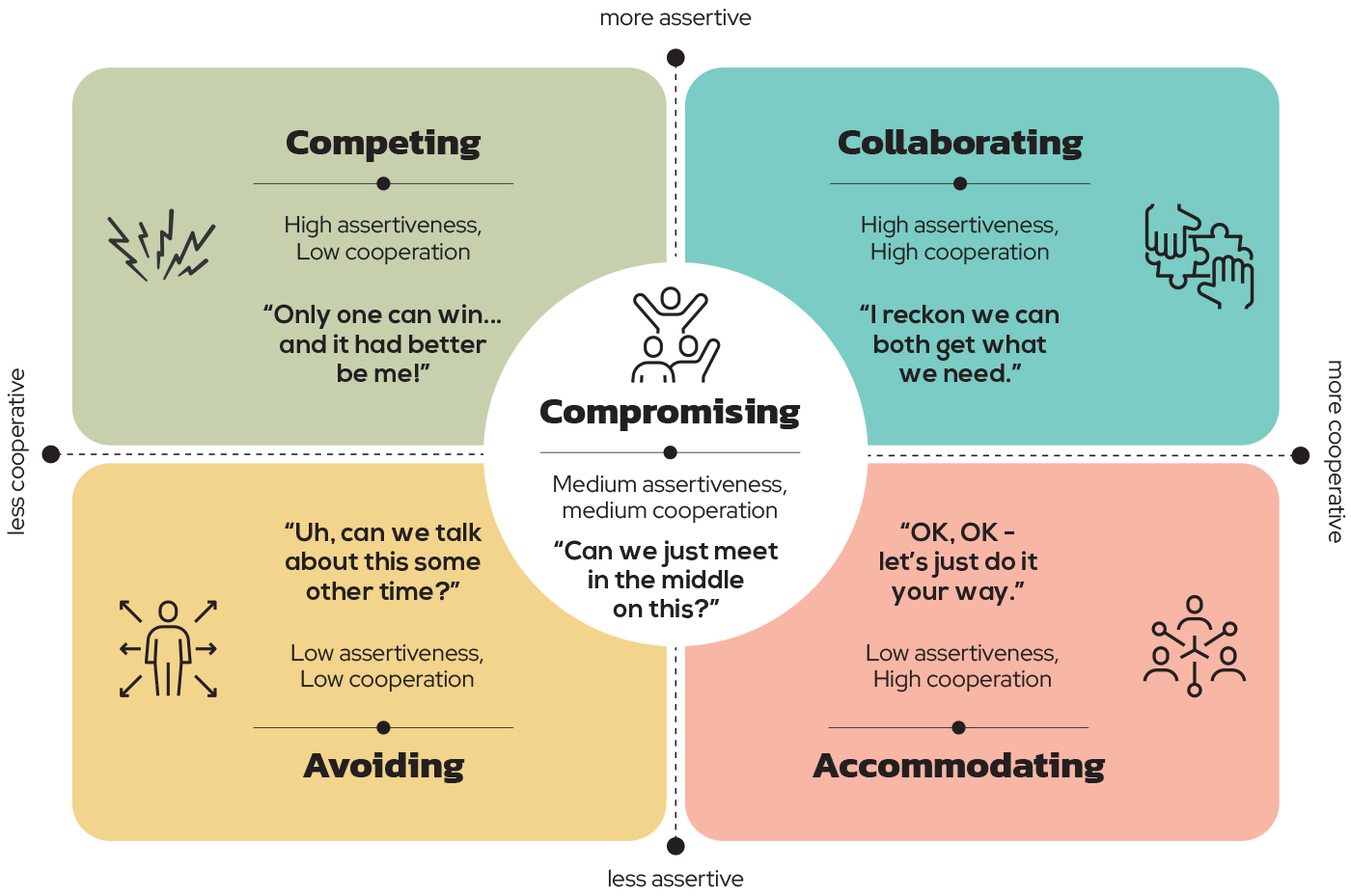Fight or Flight? Managing Emotions at Work
Ten tips to turn the tide in difficult conversations.
Ten tips to turn the tide in difficult conversations.
 By Dr Amanda Salter
By Dr Amanda Salter
What type of manager are you?
Do you shy away from fraught situations? Or do you band together with your team when trouble comes knocking at the door?
According to a 2022 Myers Briggs study, managers spend over four hours a week dealing with conflict on average. The main reasons for workplace conflict were found to be poor communication, the lack of role clarity, heavy workloads, and personality clashes.
In its simplest definition, conflict happens when two or more people have interests or goals that appear to be incompatible. As a leader you are right to be concerned about conflict – unfair or unethical behaviour, distress, disruption, and disagreement will all impact day-to-day work, increase stress, and distract people from bringing their best selves to work.
Workplace conflict comes with a hefty price tag. Few studies have been done to quantify the exact cost of workplace conflict in Asia-Pacific nations, but most research agree that the costs of conflict are the sum total of decreased work performance, increased staff leave taken, increased time and money spent on addressing conflict, and higher staff turnover.
It is possible to infer the cost of workplace conflict by examining the costs of work-related stress. A 2020 research study by Siu Oi Leng et al, Occupational Stress and its Economic Cost in Hong Kong: The Role of Positive Emotions, reports that the total cost of work-related stress in Hong Kong ranged from HKD4.81 billion to HKD7.09 billion (RM2.89 billion to RM4.26 billion) per annum.
Conflict management is therefore a critical skill for managers.

To deal with conflict when it inevitably occurs, savvy managers need to be aware of the different ways in which their people can react. The Thomas-Kilmann Conflict Management model is a well-known framework that sets out five conflict management styles that people tend to adopt: competing, avoiding, accommodating, collaborating, and compromising (see Figure 1). Depending on your culture and personality, one of these will often be your ‘default’ mode of operation, which may or may not be the best way to handle things.
There is a cultural angle to conflict management in Asia as East and West are said to lean in different directions. It is a broad stereotype that Eastern cultures are ‘collectivist’ in nature, whereas Western cultures are ‘individualist’. Collectivist cultures lean towards compromising, accommodating, and avoiding, whereas individualist cultures lean more towards competing.
Nevertheless, it would be a mistake to treat Asia as one homogenous unit. There are distinct differences reported in preferred conflict resolution styles between Asian cultures, although findings vary and sometimes clash across studies.
According to research by Kim Tae-Yeol et al titled Conflict Management Styles: The Differences among the Chinese, Japanese, and Koreans, which was published in the International Journal of Conflict Management, Koreans are more likely to ‘compromise’ when in conflict with their supervisors, whereas Japanese are more likely to ‘accommodate’.
Another study found that Chinese people treat relationships as a major factor to consider, placing high value on the concept of interpersonal harmony when resolving conflict. According to material published by Harvard Law School, South Indians tend to prefer collaborating and compromising, which is often achieved through direct confrontation and negotiation. In yet another study, Malaysians, Indonesians, and Arabs are reported to prefer collaborating, in contrast with Japanese, Chinese, and Koreans who favour avoiding.
Wheresoever the truth ultimately lies, for banks with multicultural teams working together, both Western and Eastern colleagues need to be aware that such differences exist. Teams must be equipped to apply cultural sensitivity, especially in situations of intercultural conflict. For example, the concept of ‘saving face’ is very important in Chinese culture and Western colleagues may need specific training in this area if they are to handle critical negotiation moments well.
Here are my top 10 tips for managing conflict at work.
It may be tempting to ignore a team member’s poor timekeeping, sharp tongue, or work avoidance, but these behaviours may, in fact, be the cause of stress for other colleagues. Managers need to keep their finger on the pulse of their team’s emotional state. Create opportunities to have informal one-to-one conversations with your team members. You need to quickly identify any simmering tension early, before it has a chance to fester and boil over.
Set sensible ground rules that will guide team conduct and minimise conflict. Doing this from the outset means fewer things will go awry. If a situation does blow up, everyone will know how they are expected to respond. One good ground rule for teams is to always separate the problem from the person. Avoid shaming or blaming the person, or saying that they are wrong. Instead, focus on the problem and the impact of what was said or done.
As a leader, your team looks to you to set the culture and standard for acceptable or unacceptable behaviour. You need to be courageous and swift to challenge inappropriate behaviour, such as a sexist remark or an insulting comment. Spell out the behaviours that are not tolerated. It goes without saying that you should always model good behaviour yourself.
Be self-aware and recognise your own default conflict style, its relative strengths and weaknesses, and when best to deploy it. Develop the skills you need to remain flexible and take a different approach where it’s warranted. Don’t run from conflict by default, even if this may feel like the easiest thing to do.
Leaders also need to take a lifelong approach to learning. We can’t see our own blind spots, and at some point, we are bound to become a source of stress for one of our colleagues. Actively solicit constructive feedback from your team, including your direct reports. To do this, they will need to feel safe enough to give you their honest opinion on the areas you need to work on without fear of retaliation or negative consequences.
In addition to understanding your own style, familiarise yourself with the full range of other conflict management styles, the scenarios where they are most appropriately applied, and the goals, actions, and agenda of each one. This gives you an edge in moments of conflict, enabling you to understand and anticipate other people’s behaviours and respond quickly without being taken by surprise.
Just as you may need some brushing up in this area, so might your teams. Ensure they are trained in conflict management to the competency that’s needed. Don’t forget all the other required critical soft skills, such as active listening, empathy, and negotiation.
Do your bit to de-escalate and informally resolve issues that fall within your purview. You should become the backstop that ensures issues don’t go any further than they should. Formal performance management should always be your last resort; once things get to this stage, people become more firmly entrenched in their positions, the stakes get higher, and everything becomes more difficult to resolve for all parties. You’ll need to make a judgment call on where escalation to formal action needs to be taken – this could include incidences of harassment, bullying, or discrimination.
As a leader you can’t afford to be seen to have favourites. Favouring certain individuals over others is a recipe for conflict itself. Be evidence based – gather input from multiple sources to inform your judgment and don’t just go with your gut. Teams may need or expect you to act as a mediator, so be prepared to step in as an impartial referee. Avoid taking sides and you’ll earn the loyalty, trust, and respect of your teams when you have to swoop in to resolve conflict.
Learn how to recognise and talk about emotions clearly and directly. Emotional quotient (EQ) is just as important as intelligence quotient. The failure to acknowledge and discuss feelings can derail conflict resolution before it even begins. A higher EQ enables you to better understand, interpret, and respond to other people’s emotions. You’ll be able to regulate your own feelings, communicate more effectively, and stay calm in stressful situations. People with higher EQ can also build stronger and more meaningful relationships with each other, which helps to defuse conflict more quickly.
In a psychologically safe workplace, employees will feel that they can speak up, express concerns, and ask each other the difficult questions. No one will feel that they need to cover their tracks or worry that a co-worker might throw them under the proverbial bus if conflict happens.
Take regular opportunities to invite dissenting views. This gives the strong signal that it’s ok to have a different opinion. Teams need to feel that it’s ok to deliver bad news and to admit when they have made a mistake. If someone does confess something along these lines, be mindful of your own response. Don’t play the blame game. Instead, ask them what they have learned through their experience. Higher psychological safety leads to higher engagement and motivation, and better decision-making overall. It’s also a key ingredient to smoother conflict resolution.
Despite your best efforts, the worst can still happen from time to time. A colleague can have a meltdown during a particularly stressful meeting. A chain of emails can suddenly escalate into a blazing inferno. An angry team member can run around the organisation wreaking havoc during one-to-one water cooler conversations.
If a high-drama incident happens, remain calm and in control of your emotions. Call out unacceptable behaviours, be impartial, and apply your EQ to help each party understand how their position is being perceived by the other. If the situation continues to escalate, ask the warring parties to step away from each other and cool off. A bit of time and distance can work wonders. Everyone can then come back to the table with a more level head.
Support each party to reflect on the incidents leading up to the explosion and work out the true cause of their reaction. Is there a factual misunderstanding? What feelings are at play? Was their perception of their own identity threatened? Curiosity, kindness, and compassion will bring clarity and empathy back into the discussion. To bring things to a positive conclusion, you can brainstorm improvements to the current way of working or ideas to prevent the same thing from happening in future. As a leader you can also facilitate an apology at the right moment.
By helping your teams to resolve conflict, you build resilience to handle future conflicts. The outcome that is reached should be the best for the office, not just for one employee. It may seem an unattainable utopia, but this is possible with hard work, careful facilitation, and commitment from You, the Leader.
Dr Amanda Salter is Associate Director at Akasaa, a boutique content development and consulting firm. She has delivered award-winning customer experience strategies for the Fortune 500 and been an Agile practitioner for over a decade. Previously with Accenture’s London office, Dr Salter holds a PhD in Human Centred Web Design; BSc (Hons) Computing Science, First Class; and is a certified member of the UK Market Research Society and Association for Qualitative Research.